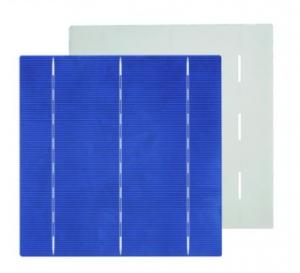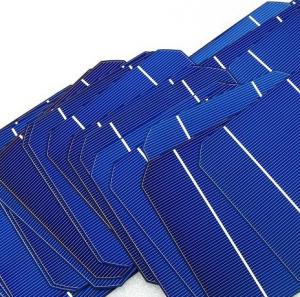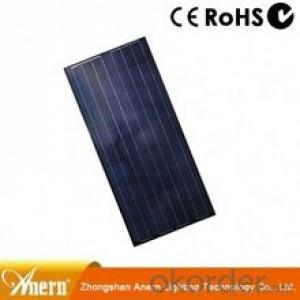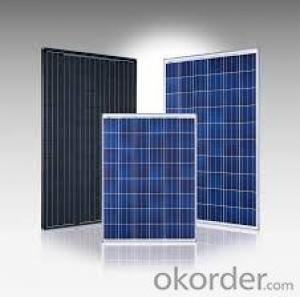Monocrystal Solar Energy Cell 156 156mm with 18.4 Efficiency
- Loading Port:
- China main port
- Payment Terms:
- TT or LC
- Min Order Qty:
- 10000 pc
- Supply Capability:
- 1000000 pc/month
OKorder Service Pledge
OKorder Financial Service
You Might Also Like
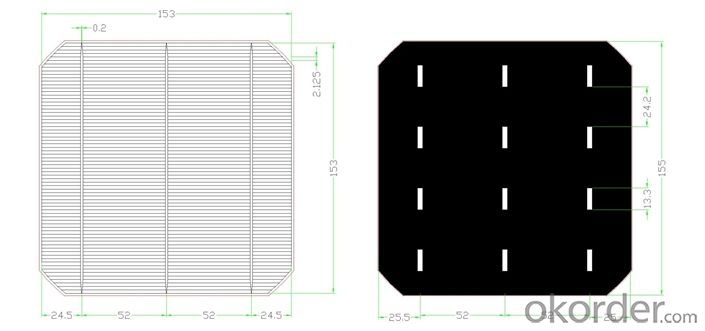
Monocrystal Solar Energy Cell
type:156M
appearance:156×1565㎜±0.5mm;diagonal:R=100mm
Main fence wide:1.4-1.5mm back electrode wide:2-2.5mm
Fence line qty:90
Cell thickness:220um±20um
Eff(%) | 18.00- 18.10 | 18.10- 18.20 | 18.20- 18.30 | 18.30- 18.40 | 18.40- 18.50 | 18.50- 18.60 | 18.60- 18.70 | 18.70- 18.80 | 18.80- 18.90 | 18.9- 19.0 | 19.1- 19.1 | 19.1- 19.2 |
Pm(W) | 4.30 | 4.33 | 4.35 | 4.37 | 4.40 | 4.42 | 4.44 | 4.47 | 4.49 | 4.52 | 4.54 | 4.56 |
Isc(A) | 8.71 | 8.73 | 8.76 | 8.77 | 8.78 | 8.82 | 8.83 | 8.85 | 8.86 | 8.88 | 8.9 | 8.93 |
Im(A) | 8.19 | 8.21 | 8.24 | 8.26 | 8.30 | 8.33 | 8.35 | 8.39 | 8.42 | 8.45 | 8.47 | 8.51 |
Voc(V) | 0.630 | 0.631 | 0.632 | 0.633 | 0.634 | 0.634 | 0.635 | 0.636 | 0.637 | 0.637 | 0.638 | 0.64 |
Vm(V) | 0.527 | 0.528 | 0.529 | 0.531 | 0.531 | 0.532 | 0.534 | 0.534 | 0.535 | 0.536 | 0.537 | 0.538 |
FF(%) | 78.6 | 78.7 | 78.8 | 79.0 | 79.2 | 79.3 | 79.5 | 79.6 | 79.8 | 80 | 80 | 80 |

remark:our company cells as per working current concentrate principle,separate the first and the second grade
Advantage of Polycrystalline Solar Cells
Tire-1 Solar Cells’ Manufacturer Quality Guarantee. With a complete and sophisticated quality government system, our Quality Management have arrived world’s leading place. Customer can receive Tire-1 Cells Maker’s Quality Standard Products.
Trusted Warranty. We can supply trusted after-sales service to our customer. If our cells are found not in conformity to the specification of manufacturer, or should the inspected quantity found in shortage, or should the packing found damaged, the buyer has the right to claim to the seller. The claim, if any, should be presented to seller within 30 days after cargo's arrival date to the port, together with related inspection report and photos issued and provided by a reputable independent surveyor such as SGS.
Factory Picture of Solar Cells
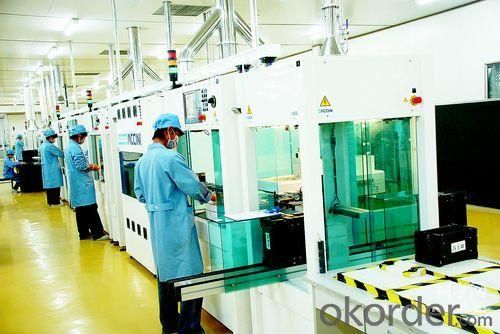
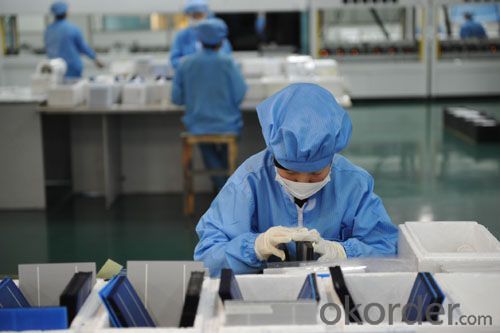
FAQ
We have organized several common questions for our clients,may help you sincerely:
What’s price per watt?
A: It’s depends on the quantity, delivery date and payment terms of the order. We can talk further about the detail price issue. Our products is high quality with lower price level.
Can you tell me the parameter of your solar cells?
We have different series of cells with different power output, both from c-si to a-si. Please take our specification sheet for your reference.
How do you pack your products?
We have rich experience on how to pack the panels to make sure the safety on shipment when it arrives at the destination.
Can you do OEM for us?
Yes, we can.
How long can we receive the product after purchase?
In the purchase of product within three working days, We will arrange the factory delivery as soon as possible. The perfect time of receiving is related to the state and position of customers. Commonly 7 to 10 working days can be served.
Solar cell power generation system and how its working
Solar panels, also known as modules, contain photovoltaic cells made from silicon that transform incoming sunlight into electricity rather than heat. Solar photovoltaic cells consist of a positive and a negative film of silicon placed under a thin slice of glass and they knock the electrons off the silicon. The negatively-charged free electrons are preferentially attracted to one side of the silicon cell, his current is gathered by wiring the individual solar panels together in series to form a solar photovoltaic array.
The inverter is typically located in an accessible location, as close as practical to the modules. In a residential application, the inverter is often mounted to the exterior sidewall of the home near the electrical main or sub panels. Since inverters make a slight noise, this should be taken into consideration when selecting the location.
In a solar electric system that is also tied to the utility grid, the DC power from the solar array is converted into 120/240 volt AC power and fed directly into the utility power distribution system of the building. The power is “net metered,” which means it reduces demand for power from the utility when the solar array is generating electricity – thus lowering the utility bill. These grid-tied systems automatically shut off if utility power goes offline, protecting workers from power being back fed into the grid during an outage. These types of solar-powered electric systems are known as “on grid” or “battery-less” and make up approximately 98% of the solar power systems being installed today..
- Q:Can solar cells be used for powering space missions?
- Yes, solar cells can be used to power space missions. Solar cells, also known as photovoltaic cells, convert sunlight directly into electricity. They have been widely deployed in space missions to provide power for satellites, space probes, and even space stations like the International Space Station (ISS). Solar cells are a reliable and efficient source of renewable energy in space, as they can generate electricity even in the absence of an atmosphere.
- Q:I know that solar cells are produced by DC and then converted into alternating current through the inverter, who explains why the solar cell is produced by DC?
- The electrons in the outer layer of the semiconductor nuclei are absorbed into the high energy level when they are exposed to light. The unstable electrons are returned to the semiconductor by the external circuit. The direction of the movement of the electrons in the external circuit is determined.
- Q:Can solar cells be used in public infrastructure projects?
- Yes, solar cells can be used in public infrastructure projects. Solar cells can be integrated into various infrastructure elements such as street lights, bus stops, parking meters, and even road surfaces to generate electricity from sunlight. This sustainable energy source can help reduce reliance on traditional power grids, lower carbon emissions, and promote renewable energy use in public spaces.
- Q:What is the impact of temperature fluctuations on solar cell efficiency?
- Temperature fluctuations can have a significant impact on solar cell efficiency. Generally, as temperatures rise, the efficiency of solar cells decreases. This is because higher temperatures can increase the resistance of the materials used in the solar cell, resulting in a decrease in the conversion of sunlight into electricity. Additionally, excessive heat can cause thermal stress and degradation of the solar cell's components, further reducing its efficiency over time. Therefore, temperature regulation and cooling mechanisms are crucial in maintaining optimal solar cell performance and maximizing energy production.
- Q:What is the difference between a solar cell and a solar panel?
- A solar cell is the basic unit that converts sunlight into electricity, while a solar panel is a collection of multiple solar cells arranged in a larger structure to generate a higher amount of electricity.
- Q:Can solar cells be used in electric fence systems?
- Yes, solar cells can be used in electric fence systems. Solar cells can generate electricity from sunlight and convert it into usable energy, which can power an electric fence system. This eliminates the need for traditional grid power or batteries, making it a cost-effective and environmentally friendly option.
- Q:Can solar cells be used in remote locations?
- Yes, solar cells can be used in remote locations. Since solar cells generate electricity from sunlight, they do not require access to a power grid, making them an ideal solution for remote areas where traditional power sources may not be readily available. Additionally, advancements in solar technology have made it possible to store excess energy in batteries, ensuring a continuous power supply even during periods of low sunlight.
- Q:Can solar cells be used in hotels?
- Yes, solar cells can definitely be used in hotels. Solar panels can be installed on the rooftops or surrounding areas of hotels to harness solar energy and generate electricity. This renewable energy source can help hotels reduce their reliance on traditional power grids, lower their carbon footprint, and save on electricity costs in the long run. Additionally, hotels can also utilize solar power for heating water, lighting outdoor spaces, or charging electric vehicles, further enhancing their sustainability initiatives.
- Q:Can solar cells be used in commercial buildings?
- Yes, solar cells can definitely be used in commercial buildings. In fact, the use of solar cells in commercial buildings is becoming increasingly popular as it offers several benefits such as reduced energy costs, environmental sustainability, and a positive brand image. With advancements in technology, solar cells can now be integrated into the design of buildings, ensuring seamless integration and aesthetic appeal. Additionally, various financing options and government incentives make solar installations financially feasible for commercial buildings, further encouraging their adoption.
- Q:Can solar cells be used for powering shopping malls?
- Yes, solar cells can be used to power shopping malls. With their ability to convert sunlight into electricity, solar cells can provide a sustainable and renewable energy source for shopping malls, reducing their reliance on traditional power grids and lowering their carbon footprint. Additionally, the large rooftop spaces available in shopping malls make them ideal for installing solar panels, maximizing energy generation potential.
1. Manufacturer Overview |
|
|---|---|
| Location | |
| Year Established | |
| Annual Output Value | |
| Main Markets | |
| Company Certifications | |
2. Manufacturer Certificates |
|
|---|---|
| a) Certification Name | |
| Range | |
| Reference | |
| Validity Period | |
3. Manufacturer Capability |
|
|---|---|
| a)Trade Capacity | |
| Nearest Port | |
| Export Percentage | |
| No.of Employees in Trade Department | |
| Language Spoken: | |
| b)Factory Information | |
| Factory Size: | |
| No. of Production Lines | |
| Contract Manufacturing | |
| Product Price Range | |
Send your message to us
Monocrystal Solar Energy Cell 156 156mm with 18.4 Efficiency
- Loading Port:
- China main port
- Payment Terms:
- TT or LC
- Min Order Qty:
- 10000 pc
- Supply Capability:
- 1000000 pc/month
OKorder Service Pledge
OKorder Financial Service
Similar products
New products
Hot products
Hot Searches
Related keywords

